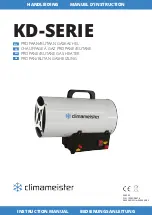
GKNE-SVX001B-EN
23
Venting
ANSI now organizes vented appliances into four
categories.
Category I
Includes non-condensing appliances with negative vent
pressure, like the traditional atmospheric unit heater.
Category II
Groups condensing appliances with negative vent
pressure.
Category III
Appliances are non-condensing and operate with a
positive vent pressure.
Category IV
Covers condensing appliances with positive vent
pressure.
All unit heaters must be vented! All Venting installations
shall be in accordance with the latest edition of Part 7,
Venting of Equipment of the National Fuel Gas Code, ANSI
Z223.1 (NFPA54), or applicable provisions of local building
codes. Refer to page 24 for Canadian installations. Refer to
,
,
.
Do not damper or add heat recovery devices to the flue
piping. Failure to open such a damper prior to operating
gas unit will result in the spillage of flue gas into the
occupied space.
Vertically Vented Unit Heaters
(Category I)
Observe the following precautions when venting the unit:
1. Use flue pipe of the same size as the flue connections
on the gas unit heater (See Table #1). All heaters
should be vented with double wall or single wall vent,
a factory built chimney, or a lined brick and mortar
chimney that has been constructed in accordance with
the National Building Code. Type B vent should only be
used for vertical rise portions of a Category I vent pipe
system. Type B vent pipe should not be used for
horizontal runs of vent pipe.
2. Provide as long a vertical run of flue pipe at the gas unit
heater as possible. A minimum of 5 ft. (1.5m) of vertical
flue is required. The top of the vent pipe should extend
at least 2 ft. (0.61m) above the highest point on the
roof. Install a weather cap over the vent opening.
Consideration should be made for anticipated snow
depth.
3. Slope horizontal runs upward from the gas unit heater
at least 1/4-inch per ft. (21mm/m) minimum. Horizontal
runs should not exceed 75% of the vertical height of the
vent pipe, or chimney, above the flue pipe connection,
up to a maximum length of 10 foot (3m). Horizontal
portions of the venting system shall be supported at
minimum intervals of 4 foot (1.2m). In Canada, support
at minimum intervals of 3 foot (1m).
4. Use as few elbows as possible.
5. Seal all vent pipe joints and seams to prevent leakage.
Use General Electric RTV-108, Dow Corning RTV-732,
or equivalent silicone sealant with a temperature
rating of 500 degrees F, or 3M #425 aluminum foil tape
(or equivalent).
6. Avoid running vent pipe through unheated spaces.
7. When this cannot be avoided, insulate the pipe to
prevent condensation of moisture on the walls of the
pipe.
8. Do not damper the flue piping. Failure to open such a
damper prior to operating the gas unit heater will
result in the spillage of flue gas into the occupied
space.
9. Avoid installing units in areas under negative pressure
due to large exhaust fans or air conditioning. When
required, a flue vent fan should be installed in
accordance with the instructions included with the fan.
10. Vent connectors serving Category I and Category II
heaters shall not be connected into any portion of
mechanical draft systems operating under positive
pressure.
Table 7.
Venting categories
Non Condensing
Condensing
Negative Vent
Pressure
I
II
Positive Vent
Pressure
III
IV
NOTICE
Category II and IV do not apply to equipment specified
within this manual.
WARNING
Carbon Monoxide!
Your venting system must not be blocked by any snow,
snow drifts, or any foreign matter. Inspect your venting
system to ensure adequate ventilation exists at all
times! Failure to heed these warnings could result in
Carbon Monoxide Poisoning (symptoms include
grogginess, lethargy, inappropriate tiredness, or flu-like
symptoms).
















































